A Study on the Implied Freedom of Political Communication in Australia
VerifiedAdded on 2022/10/04
|7
|2212
|15
Essay
AI Summary
This essay provides a comprehensive analysis of the implied freedom of political communication within the Australian legal system. It begins by defining the concept and its constitutional origins, emphasizing its role in restricting executive and legislative powers, rather than conferring individual rights. The essay traces the development of this freedom, highlighting the landmark Lange case and the subsequent application of the Lange test to determine the validity of laws that may restrict political communication. It explores the strict application of the implied freedom, examining cases like Coleman v Power and Mulholland V Australian Electoral Commission to illustrate how courts assess its scope. The essay also examines the restriction on both executive and legislative powers, with reference to cases like Nationwide News Pty Ltd v Wills and Levy v Victoria. Furthermore, it delves into the proportionality analysis, using the McCoy v New South Wales case as an example of the German proportionality test. The essay concludes by summarizing the key points, emphasizing the importance of the implied freedom in upholding representative democracy and protecting against government overreach.
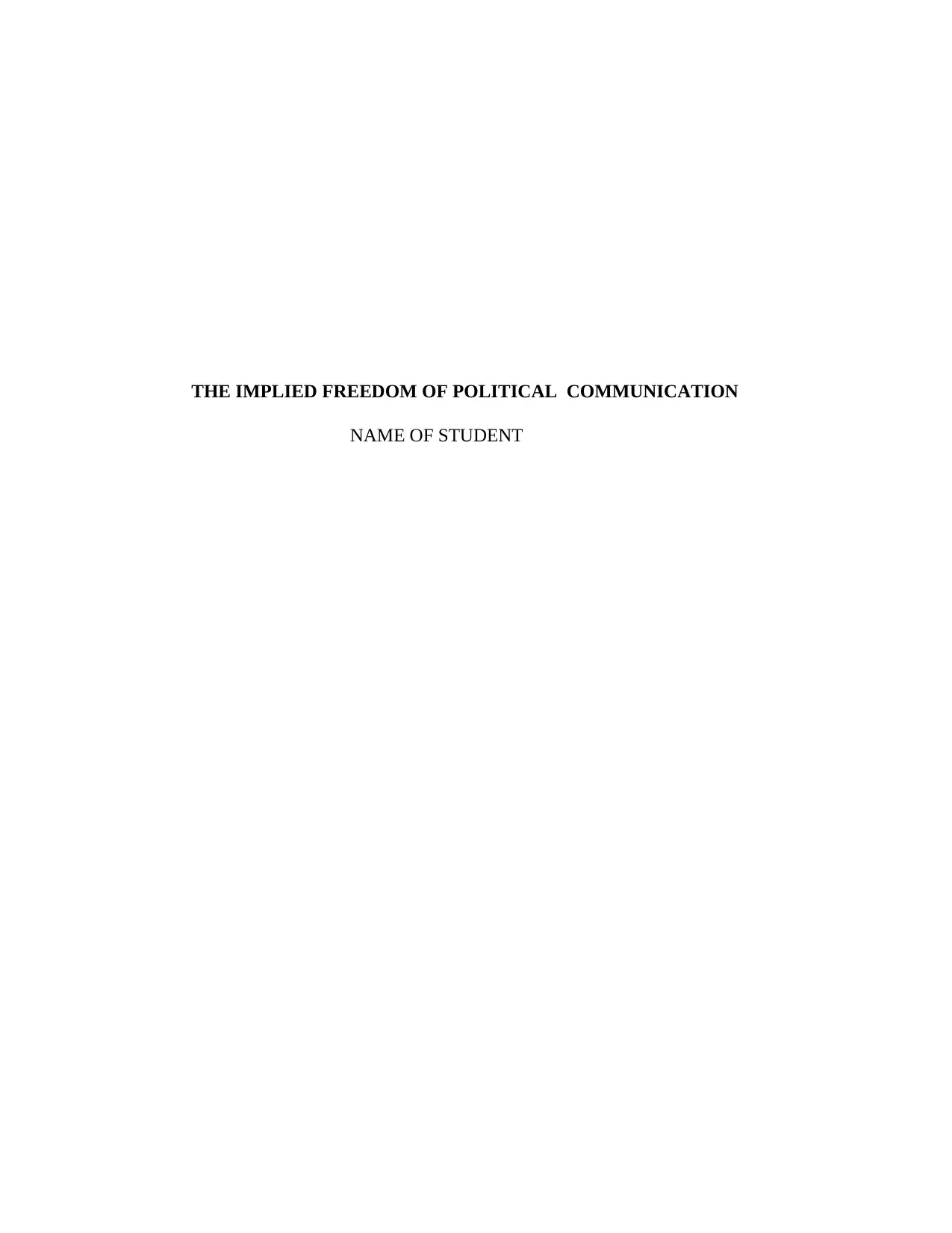
THE IMPLIED FREEDOM OF POLITICAL COMMUNICATION
NAME OF STUDENT
NAME OF STUDENT
Paraphrase This Document
Need a fresh take? Get an instant paraphrase of this document with our AI Paraphraser
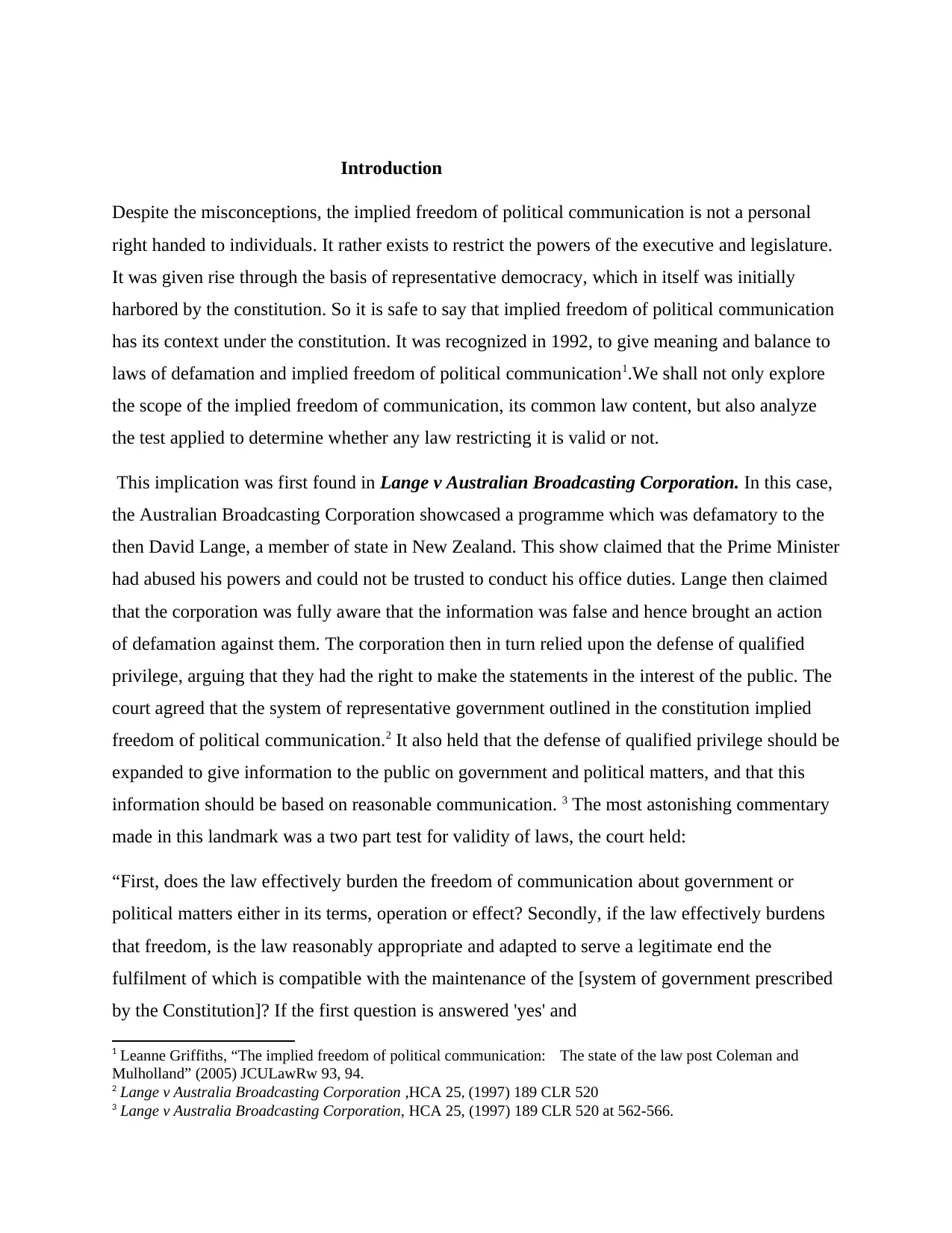
Introduction
Despite the misconceptions, the implied freedom of political communication is not a personal
right handed to individuals. It rather exists to restrict the powers of the executive and legislature.
It was given rise through the basis of representative democracy, which in itself was initially
harbored by the constitution. So it is safe to say that implied freedom of political communication
has its context under the constitution. It was recognized in 1992, to give meaning and balance to
laws of defamation and implied freedom of political communication1.We shall not only explore
the scope of the implied freedom of communication, its common law content, but also analyze
the test applied to determine whether any law restricting it is valid or not.
This implication was first found in Lange v Australian Broadcasting Corporation. In this case,
the Australian Broadcasting Corporation showcased a programme which was defamatory to the
then David Lange, a member of state in New Zealand. This show claimed that the Prime Minister
had abused his powers and could not be trusted to conduct his office duties. Lange then claimed
that the corporation was fully aware that the information was false and hence brought an action
of defamation against them. The corporation then in turn relied upon the defense of qualified
privilege, arguing that they had the right to make the statements in the interest of the public. The
court agreed that the system of representative government outlined in the constitution implied
freedom of political communication.2 It also held that the defense of qualified privilege should be
expanded to give information to the public on government and political matters, and that this
information should be based on reasonable communication. 3 The most astonishing commentary
made in this landmark was a two part test for validity of laws, the court held:
“First, does the law effectively burden the freedom of communication about government or
political matters either in its terms, operation or effect? Secondly, if the law effectively burdens
that freedom, is the law reasonably appropriate and adapted to serve a legitimate end the
fulfilment of which is compatible with the maintenance of the [system of government prescribed
by the Constitution]? If the first question is answered 'yes' and
1 Leanne Griffiths, “The implied freedom of political communication: The state of the law post Coleman and
Mulholland” (2005) JCULawRw 93, 94.
2 Lange v Australia Broadcasting Corporation ,HCA 25, (1997) 189 CLR 520
3 Lange v Australia Broadcasting Corporation, HCA 25, (1997) 189 CLR 520 at 562-566.
Despite the misconceptions, the implied freedom of political communication is not a personal
right handed to individuals. It rather exists to restrict the powers of the executive and legislature.
It was given rise through the basis of representative democracy, which in itself was initially
harbored by the constitution. So it is safe to say that implied freedom of political communication
has its context under the constitution. It was recognized in 1992, to give meaning and balance to
laws of defamation and implied freedom of political communication1.We shall not only explore
the scope of the implied freedom of communication, its common law content, but also analyze
the test applied to determine whether any law restricting it is valid or not.
This implication was first found in Lange v Australian Broadcasting Corporation. In this case,
the Australian Broadcasting Corporation showcased a programme which was defamatory to the
then David Lange, a member of state in New Zealand. This show claimed that the Prime Minister
had abused his powers and could not be trusted to conduct his office duties. Lange then claimed
that the corporation was fully aware that the information was false and hence brought an action
of defamation against them. The corporation then in turn relied upon the defense of qualified
privilege, arguing that they had the right to make the statements in the interest of the public. The
court agreed that the system of representative government outlined in the constitution implied
freedom of political communication.2 It also held that the defense of qualified privilege should be
expanded to give information to the public on government and political matters, and that this
information should be based on reasonable communication. 3 The most astonishing commentary
made in this landmark was a two part test for validity of laws, the court held:
“First, does the law effectively burden the freedom of communication about government or
political matters either in its terms, operation or effect? Secondly, if the law effectively burdens
that freedom, is the law reasonably appropriate and adapted to serve a legitimate end the
fulfilment of which is compatible with the maintenance of the [system of government prescribed
by the Constitution]? If the first question is answered 'yes' and
1 Leanne Griffiths, “The implied freedom of political communication: The state of the law post Coleman and
Mulholland” (2005) JCULawRw 93, 94.
2 Lange v Australia Broadcasting Corporation ,HCA 25, (1997) 189 CLR 520
3 Lange v Australia Broadcasting Corporation, HCA 25, (1997) 189 CLR 520 at 562-566.
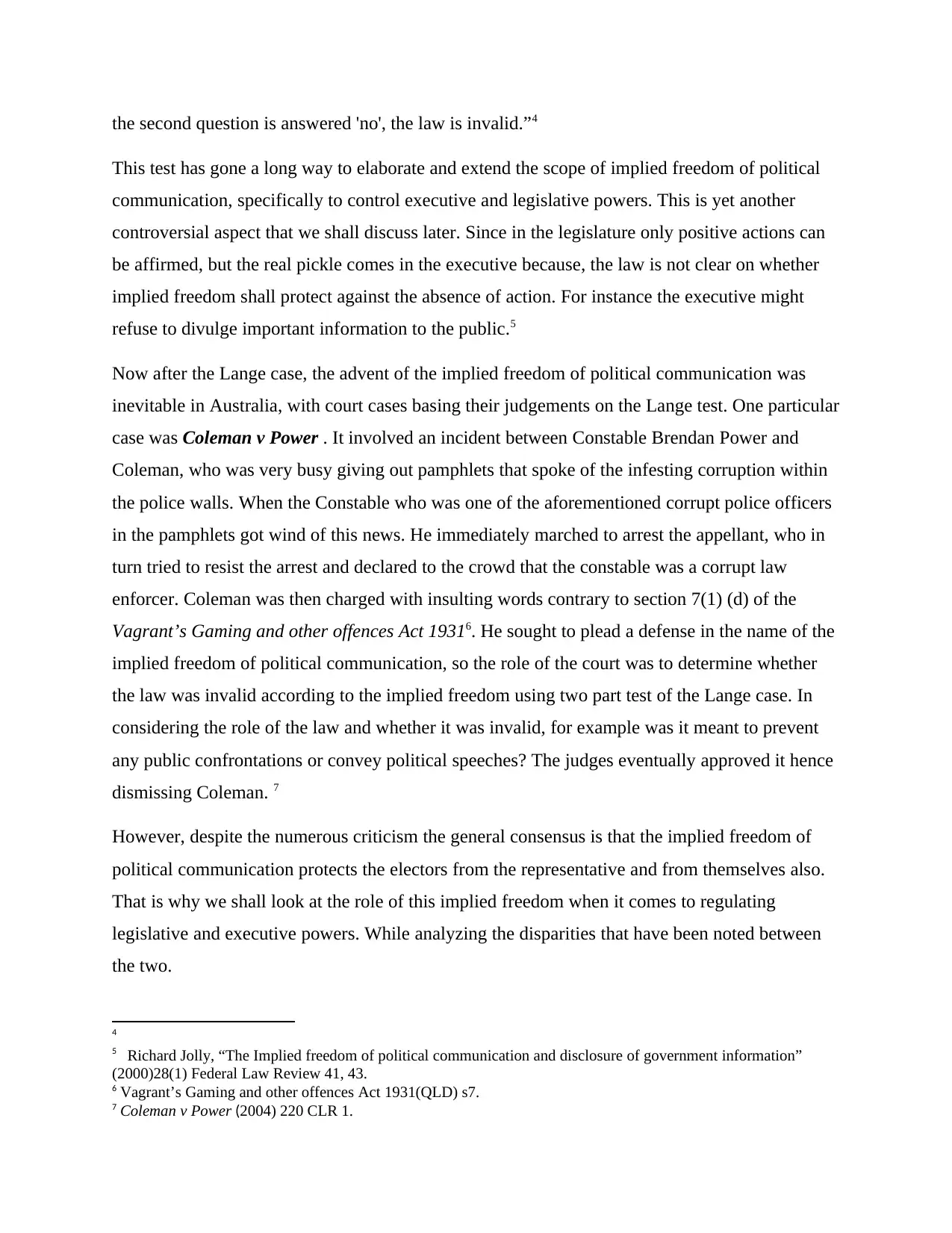
the second question is answered 'no', the law is invalid.”4
This test has gone a long way to elaborate and extend the scope of implied freedom of political
communication, specifically to control executive and legislative powers. This is yet another
controversial aspect that we shall discuss later. Since in the legislature only positive actions can
be affirmed, but the real pickle comes in the executive because, the law is not clear on whether
implied freedom shall protect against the absence of action. For instance the executive might
refuse to divulge important information to the public.5
Now after the Lange case, the advent of the implied freedom of political communication was
inevitable in Australia, with court cases basing their judgements on the Lange test. One particular
case was Coleman v Power . It involved an incident between Constable Brendan Power and
Coleman, who was very busy giving out pamphlets that spoke of the infesting corruption within
the police walls. When the Constable who was one of the aforementioned corrupt police officers
in the pamphlets got wind of this news. He immediately marched to arrest the appellant, who in
turn tried to resist the arrest and declared to the crowd that the constable was a corrupt law
enforcer. Coleman was then charged with insulting words contrary to section 7(1) (d) of the
Vagrant’s Gaming and other offences Act 19316. He sought to plead a defense in the name of the
implied freedom of political communication, so the role of the court was to determine whether
the law was invalid according to the implied freedom using two part test of the Lange case. In
considering the role of the law and whether it was invalid, for example was it meant to prevent
any public confrontations or convey political speeches? The judges eventually approved it hence
dismissing Coleman. 7
However, despite the numerous criticism the general consensus is that the implied freedom of
political communication protects the electors from the representative and from themselves also.
That is why we shall look at the role of this implied freedom when it comes to regulating
legislative and executive powers. While analyzing the disparities that have been noted between
the two.
4
5 Richard Jolly, “The Implied freedom of political communication and disclosure of government information”
(2000)28(1) Federal Law Review 41, 43.
6 Vagrant’s Gaming and other offences Act 1931(QLD) s7.
7 Coleman v Power (2004) 220 CLR 1.
This test has gone a long way to elaborate and extend the scope of implied freedom of political
communication, specifically to control executive and legislative powers. This is yet another
controversial aspect that we shall discuss later. Since in the legislature only positive actions can
be affirmed, but the real pickle comes in the executive because, the law is not clear on whether
implied freedom shall protect against the absence of action. For instance the executive might
refuse to divulge important information to the public.5
Now after the Lange case, the advent of the implied freedom of political communication was
inevitable in Australia, with court cases basing their judgements on the Lange test. One particular
case was Coleman v Power . It involved an incident between Constable Brendan Power and
Coleman, who was very busy giving out pamphlets that spoke of the infesting corruption within
the police walls. When the Constable who was one of the aforementioned corrupt police officers
in the pamphlets got wind of this news. He immediately marched to arrest the appellant, who in
turn tried to resist the arrest and declared to the crowd that the constable was a corrupt law
enforcer. Coleman was then charged with insulting words contrary to section 7(1) (d) of the
Vagrant’s Gaming and other offences Act 19316. He sought to plead a defense in the name of the
implied freedom of political communication, so the role of the court was to determine whether
the law was invalid according to the implied freedom using two part test of the Lange case. In
considering the role of the law and whether it was invalid, for example was it meant to prevent
any public confrontations or convey political speeches? The judges eventually approved it hence
dismissing Coleman. 7
However, despite the numerous criticism the general consensus is that the implied freedom of
political communication protects the electors from the representative and from themselves also.
That is why we shall look at the role of this implied freedom when it comes to regulating
legislative and executive powers. While analyzing the disparities that have been noted between
the two.
4
5 Richard Jolly, “The Implied freedom of political communication and disclosure of government information”
(2000)28(1) Federal Law Review 41, 43.
6 Vagrant’s Gaming and other offences Act 1931(QLD) s7.
7 Coleman v Power (2004) 220 CLR 1.
⊘ This is a preview!⊘
Do you want full access?
Subscribe today to unlock all pages.

Trusted by 1+ million students worldwide
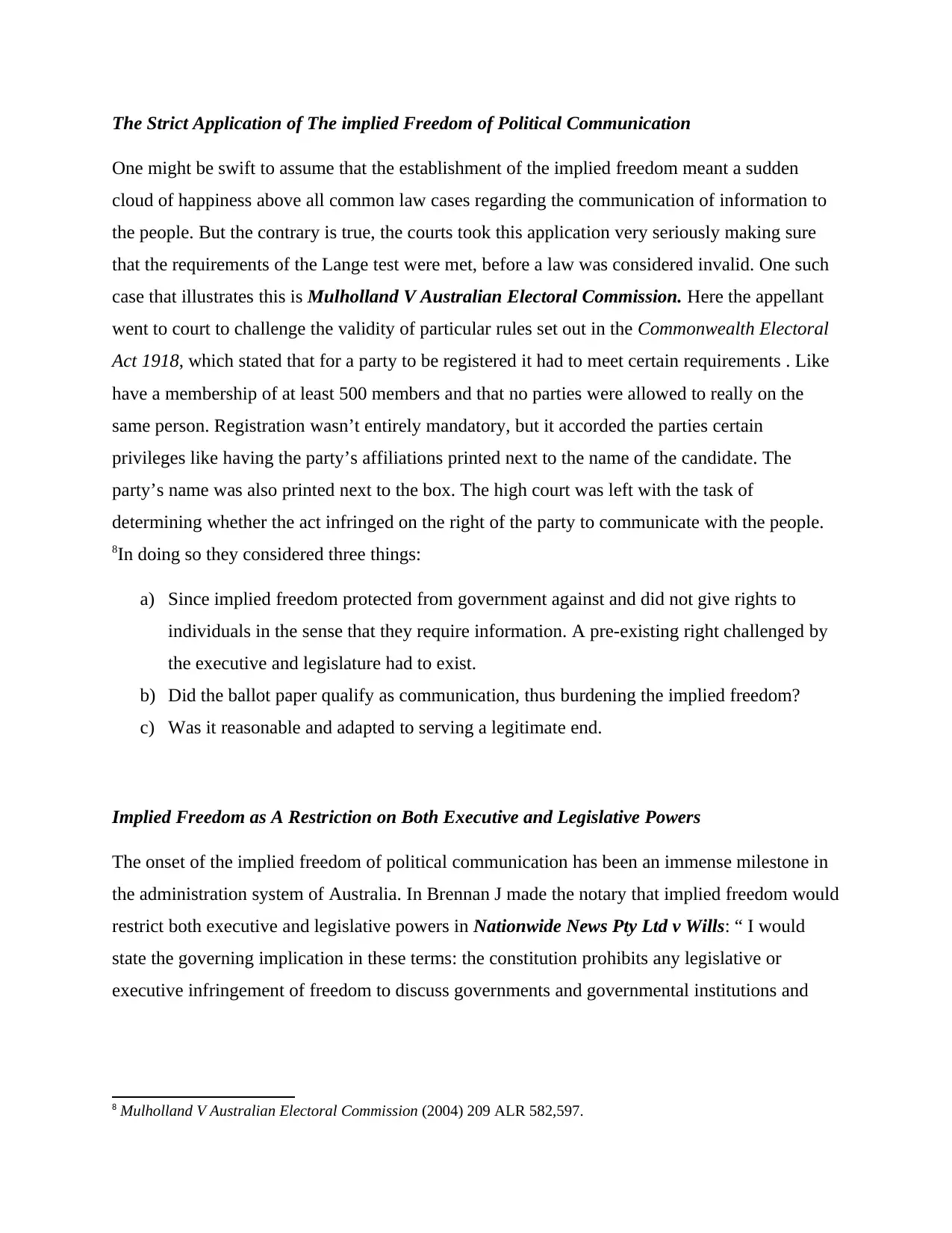
The Strict Application of The implied Freedom of Political Communication
One might be swift to assume that the establishment of the implied freedom meant a sudden
cloud of happiness above all common law cases regarding the communication of information to
the people. But the contrary is true, the courts took this application very seriously making sure
that the requirements of the Lange test were met, before a law was considered invalid. One such
case that illustrates this is Mulholland V Australian Electoral Commission. Here the appellant
went to court to challenge the validity of particular rules set out in the Commonwealth Electoral
Act 1918, which stated that for a party to be registered it had to meet certain requirements . Like
have a membership of at least 500 members and that no parties were allowed to really on the
same person. Registration wasn’t entirely mandatory, but it accorded the parties certain
privileges like having the party’s affiliations printed next to the name of the candidate. The
party’s name was also printed next to the box. The high court was left with the task of
determining whether the act infringed on the right of the party to communicate with the people.
8In doing so they considered three things:
a) Since implied freedom protected from government against and did not give rights to
individuals in the sense that they require information. A pre-existing right challenged by
the executive and legislature had to exist.
b) Did the ballot paper qualify as communication, thus burdening the implied freedom?
c) Was it reasonable and adapted to serving a legitimate end.
Implied Freedom as A Restriction on Both Executive and Legislative Powers
The onset of the implied freedom of political communication has been an immense milestone in
the administration system of Australia. In Brennan J made the notary that implied freedom would
restrict both executive and legislative powers in Nationwide News Pty Ltd v Wills: “ I would
state the governing implication in these terms: the constitution prohibits any legislative or
executive infringement of freedom to discuss governments and governmental institutions and
8 Mulholland V Australian Electoral Commission (2004) 209 ALR 582,597.
One might be swift to assume that the establishment of the implied freedom meant a sudden
cloud of happiness above all common law cases regarding the communication of information to
the people. But the contrary is true, the courts took this application very seriously making sure
that the requirements of the Lange test were met, before a law was considered invalid. One such
case that illustrates this is Mulholland V Australian Electoral Commission. Here the appellant
went to court to challenge the validity of particular rules set out in the Commonwealth Electoral
Act 1918, which stated that for a party to be registered it had to meet certain requirements . Like
have a membership of at least 500 members and that no parties were allowed to really on the
same person. Registration wasn’t entirely mandatory, but it accorded the parties certain
privileges like having the party’s affiliations printed next to the name of the candidate. The
party’s name was also printed next to the box. The high court was left with the task of
determining whether the act infringed on the right of the party to communicate with the people.
8In doing so they considered three things:
a) Since implied freedom protected from government against and did not give rights to
individuals in the sense that they require information. A pre-existing right challenged by
the executive and legislature had to exist.
b) Did the ballot paper qualify as communication, thus burdening the implied freedom?
c) Was it reasonable and adapted to serving a legitimate end.
Implied Freedom as A Restriction on Both Executive and Legislative Powers
The onset of the implied freedom of political communication has been an immense milestone in
the administration system of Australia. In Brennan J made the notary that implied freedom would
restrict both executive and legislative powers in Nationwide News Pty Ltd v Wills: “ I would
state the governing implication in these terms: the constitution prohibits any legislative or
executive infringement of freedom to discuss governments and governmental institutions and
8 Mulholland V Australian Electoral Commission (2004) 209 ALR 582,597.
Paraphrase This Document
Need a fresh take? Get an instant paraphrase of this document with our AI Paraphraser
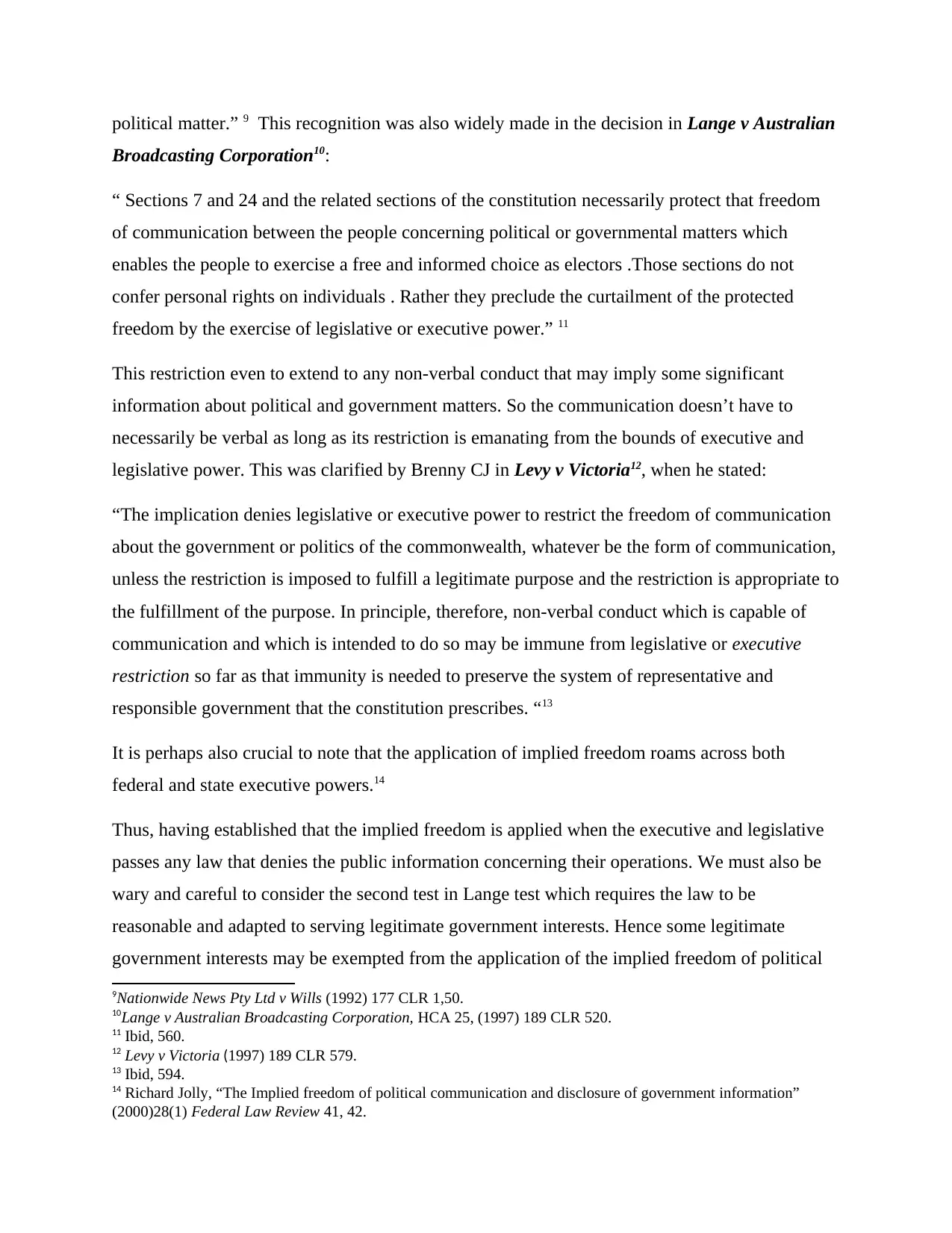
political matter.” 9 This recognition was also widely made in the decision in Lange v Australian
Broadcasting Corporation10:
“ Sections 7 and 24 and the related sections of the constitution necessarily protect that freedom
of communication between the people concerning political or governmental matters which
enables the people to exercise a free and informed choice as electors .Those sections do not
confer personal rights on individuals . Rather they preclude the curtailment of the protected
freedom by the exercise of legislative or executive power.” 11
This restriction even to extend to any non-verbal conduct that may imply some significant
information about political and government matters. So the communication doesn’t have to
necessarily be verbal as long as its restriction is emanating from the bounds of executive and
legislative power. This was clarified by Brenny CJ in Levy v Victoria12, when he stated:
“The implication denies legislative or executive power to restrict the freedom of communication
about the government or politics of the commonwealth, whatever be the form of communication,
unless the restriction is imposed to fulfill a legitimate purpose and the restriction is appropriate to
the fulfillment of the purpose. In principle, therefore, non-verbal conduct which is capable of
communication and which is intended to do so may be immune from legislative or executive
restriction so far as that immunity is needed to preserve the system of representative and
responsible government that the constitution prescribes. “13
It is perhaps also crucial to note that the application of implied freedom roams across both
federal and state executive powers.14
Thus, having established that the implied freedom is applied when the executive and legislative
passes any law that denies the public information concerning their operations. We must also be
wary and careful to consider the second test in Lange test which requires the law to be
reasonable and adapted to serving legitimate government interests. Hence some legitimate
government interests may be exempted from the application of the implied freedom of political
9Nationwide News Pty Ltd v Wills (1992) 177 CLR 1,50.
10Lange v Australian Broadcasting Corporation, HCA 25, (1997) 189 CLR 520.
11 Ibid, 560.
12 Levy v Victoria (1997) 189 CLR 579.
13 Ibid, 594.
14 Richard Jolly, “The Implied freedom of political communication and disclosure of government information”
(2000)28(1) Federal Law Review 41, 42.
Broadcasting Corporation10:
“ Sections 7 and 24 and the related sections of the constitution necessarily protect that freedom
of communication between the people concerning political or governmental matters which
enables the people to exercise a free and informed choice as electors .Those sections do not
confer personal rights on individuals . Rather they preclude the curtailment of the protected
freedom by the exercise of legislative or executive power.” 11
This restriction even to extend to any non-verbal conduct that may imply some significant
information about political and government matters. So the communication doesn’t have to
necessarily be verbal as long as its restriction is emanating from the bounds of executive and
legislative power. This was clarified by Brenny CJ in Levy v Victoria12, when he stated:
“The implication denies legislative or executive power to restrict the freedom of communication
about the government or politics of the commonwealth, whatever be the form of communication,
unless the restriction is imposed to fulfill a legitimate purpose and the restriction is appropriate to
the fulfillment of the purpose. In principle, therefore, non-verbal conduct which is capable of
communication and which is intended to do so may be immune from legislative or executive
restriction so far as that immunity is needed to preserve the system of representative and
responsible government that the constitution prescribes. “13
It is perhaps also crucial to note that the application of implied freedom roams across both
federal and state executive powers.14
Thus, having established that the implied freedom is applied when the executive and legislative
passes any law that denies the public information concerning their operations. We must also be
wary and careful to consider the second test in Lange test which requires the law to be
reasonable and adapted to serving legitimate government interests. Hence some legitimate
government interests may be exempted from the application of the implied freedom of political
9Nationwide News Pty Ltd v Wills (1992) 177 CLR 1,50.
10Lange v Australian Broadcasting Corporation, HCA 25, (1997) 189 CLR 520.
11 Ibid, 560.
12 Levy v Victoria (1997) 189 CLR 579.
13 Ibid, 594.
14 Richard Jolly, “The Implied freedom of political communication and disclosure of government information”
(2000)28(1) Federal Law Review 41, 42.
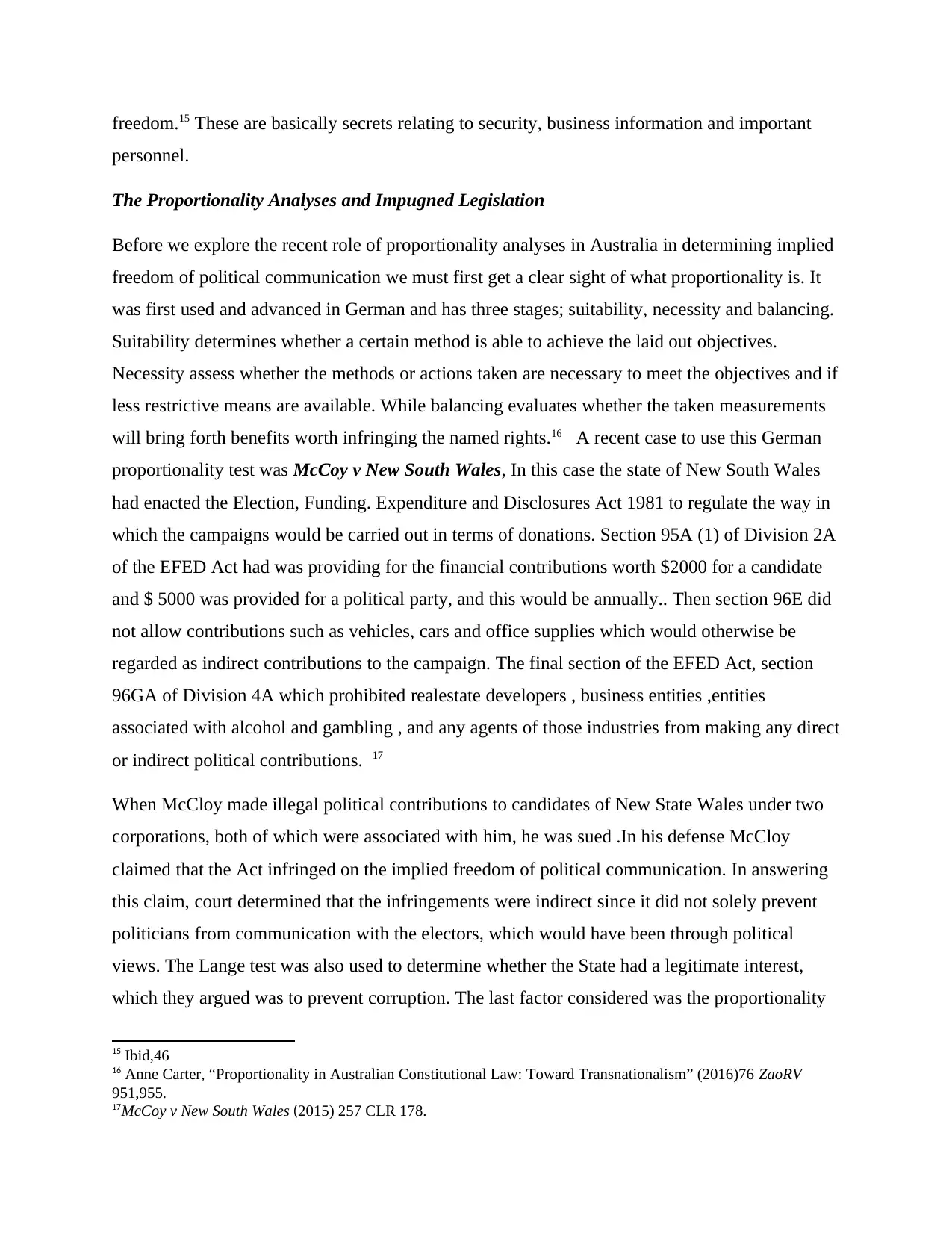
freedom.15 These are basically secrets relating to security, business information and important
personnel.
The Proportionality Analyses and Impugned Legislation
Before we explore the recent role of proportionality analyses in Australia in determining implied
freedom of political communication we must first get a clear sight of what proportionality is. It
was first used and advanced in German and has three stages; suitability, necessity and balancing.
Suitability determines whether a certain method is able to achieve the laid out objectives.
Necessity assess whether the methods or actions taken are necessary to meet the objectives and if
less restrictive means are available. While balancing evaluates whether the taken measurements
will bring forth benefits worth infringing the named rights.16 A recent case to use this German
proportionality test was McCoy v New South Wales, In this case the state of New South Wales
had enacted the Election, Funding. Expenditure and Disclosures Act 1981 to regulate the way in
which the campaigns would be carried out in terms of donations. Section 95A (1) of Division 2A
of the EFED Act had was providing for the financial contributions worth $2000 for a candidate
and $ 5000 was provided for a political party, and this would be annually.. Then section 96E did
not allow contributions such as vehicles, cars and office supplies which would otherwise be
regarded as indirect contributions to the campaign. The final section of the EFED Act, section
96GA of Division 4A which prohibited realestate developers , business entities ,entities
associated with alcohol and gambling , and any agents of those industries from making any direct
or indirect political contributions. 17
When McCloy made illegal political contributions to candidates of New State Wales under two
corporations, both of which were associated with him, he was sued .In his defense McCloy
claimed that the Act infringed on the implied freedom of political communication. In answering
this claim, court determined that the infringements were indirect since it did not solely prevent
politicians from communication with the electors, which would have been through political
views. The Lange test was also used to determine whether the State had a legitimate interest,
which they argued was to prevent corruption. The last factor considered was the proportionality
15 Ibid,46
16 Anne Carter, “Proportionality in Australian Constitutional Law: Toward Transnationalism” (2016)76 ZaoRV
951,955.
17McCoy v New South Wales (2015) 257 CLR 178.
personnel.
The Proportionality Analyses and Impugned Legislation
Before we explore the recent role of proportionality analyses in Australia in determining implied
freedom of political communication we must first get a clear sight of what proportionality is. It
was first used and advanced in German and has three stages; suitability, necessity and balancing.
Suitability determines whether a certain method is able to achieve the laid out objectives.
Necessity assess whether the methods or actions taken are necessary to meet the objectives and if
less restrictive means are available. While balancing evaluates whether the taken measurements
will bring forth benefits worth infringing the named rights.16 A recent case to use this German
proportionality test was McCoy v New South Wales, In this case the state of New South Wales
had enacted the Election, Funding. Expenditure and Disclosures Act 1981 to regulate the way in
which the campaigns would be carried out in terms of donations. Section 95A (1) of Division 2A
of the EFED Act had was providing for the financial contributions worth $2000 for a candidate
and $ 5000 was provided for a political party, and this would be annually.. Then section 96E did
not allow contributions such as vehicles, cars and office supplies which would otherwise be
regarded as indirect contributions to the campaign. The final section of the EFED Act, section
96GA of Division 4A which prohibited realestate developers , business entities ,entities
associated with alcohol and gambling , and any agents of those industries from making any direct
or indirect political contributions. 17
When McCloy made illegal political contributions to candidates of New State Wales under two
corporations, both of which were associated with him, he was sued .In his defense McCloy
claimed that the Act infringed on the implied freedom of political communication. In answering
this claim, court determined that the infringements were indirect since it did not solely prevent
politicians from communication with the electors, which would have been through political
views. The Lange test was also used to determine whether the State had a legitimate interest,
which they argued was to prevent corruption. The last factor considered was the proportionality
15 Ibid,46
16 Anne Carter, “Proportionality in Australian Constitutional Law: Toward Transnationalism” (2016)76 ZaoRV
951,955.
17McCoy v New South Wales (2015) 257 CLR 178.
⊘ This is a preview!⊘
Do you want full access?
Subscribe today to unlock all pages.

Trusted by 1+ million students worldwide
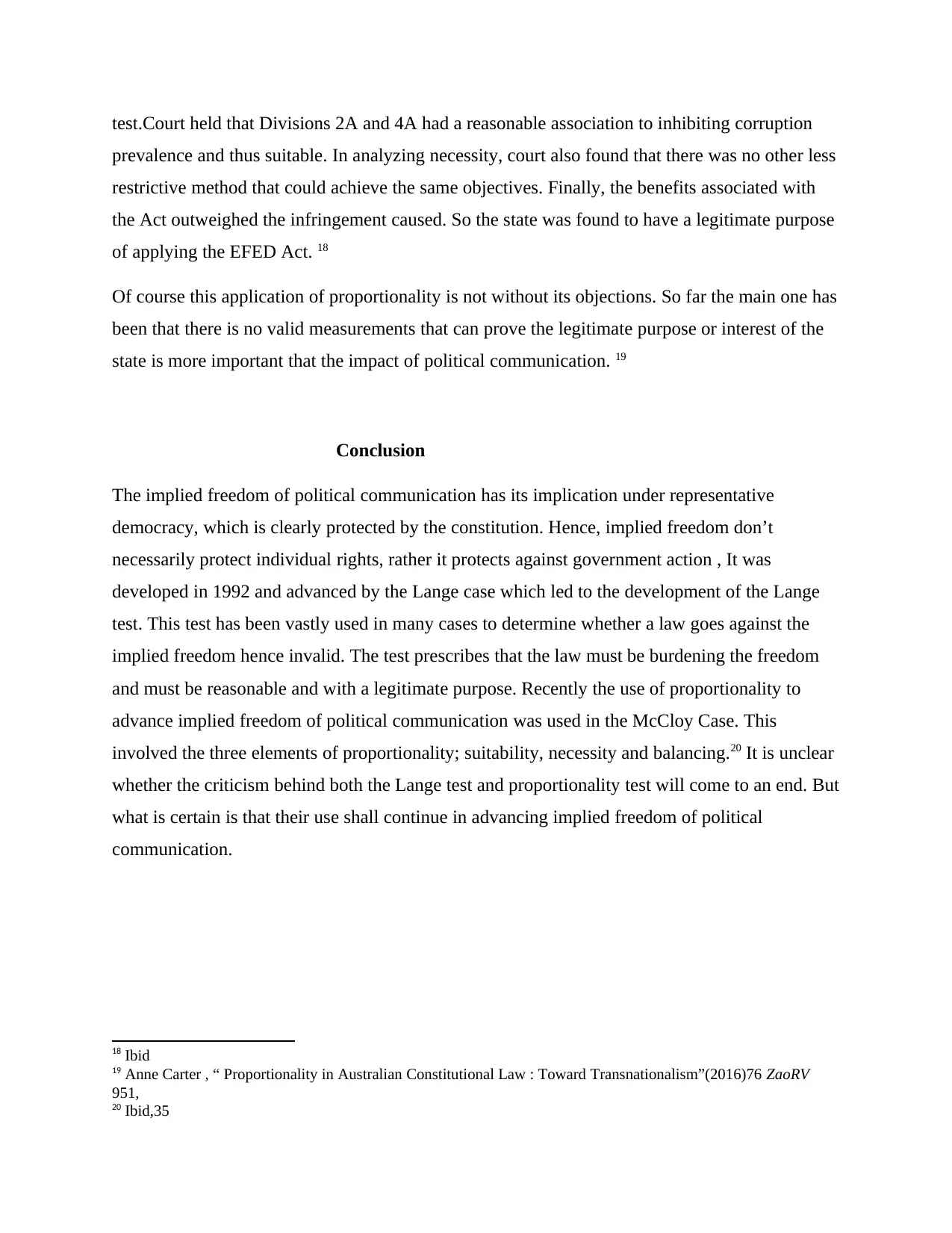
test.Court held that Divisions 2A and 4A had a reasonable association to inhibiting corruption
prevalence and thus suitable. In analyzing necessity, court also found that there was no other less
restrictive method that could achieve the same objectives. Finally, the benefits associated with
the Act outweighed the infringement caused. So the state was found to have a legitimate purpose
of applying the EFED Act. 18
Of course this application of proportionality is not without its objections. So far the main one has
been that there is no valid measurements that can prove the legitimate purpose or interest of the
state is more important that the impact of political communication. 19
Conclusion
The implied freedom of political communication has its implication under representative
democracy, which is clearly protected by the constitution. Hence, implied freedom don’t
necessarily protect individual rights, rather it protects against government action , It was
developed in 1992 and advanced by the Lange case which led to the development of the Lange
test. This test has been vastly used in many cases to determine whether a law goes against the
implied freedom hence invalid. The test prescribes that the law must be burdening the freedom
and must be reasonable and with a legitimate purpose. Recently the use of proportionality to
advance implied freedom of political communication was used in the McCloy Case. This
involved the three elements of proportionality; suitability, necessity and balancing.20 It is unclear
whether the criticism behind both the Lange test and proportionality test will come to an end. But
what is certain is that their use shall continue in advancing implied freedom of political
communication.
18 Ibid
19 Anne Carter , “ Proportionality in Australian Constitutional Law : Toward Transnationalism”(2016)76 ZaoRV
951,
20 Ibid,35
prevalence and thus suitable. In analyzing necessity, court also found that there was no other less
restrictive method that could achieve the same objectives. Finally, the benefits associated with
the Act outweighed the infringement caused. So the state was found to have a legitimate purpose
of applying the EFED Act. 18
Of course this application of proportionality is not without its objections. So far the main one has
been that there is no valid measurements that can prove the legitimate purpose or interest of the
state is more important that the impact of political communication. 19
Conclusion
The implied freedom of political communication has its implication under representative
democracy, which is clearly protected by the constitution. Hence, implied freedom don’t
necessarily protect individual rights, rather it protects against government action , It was
developed in 1992 and advanced by the Lange case which led to the development of the Lange
test. This test has been vastly used in many cases to determine whether a law goes against the
implied freedom hence invalid. The test prescribes that the law must be burdening the freedom
and must be reasonable and with a legitimate purpose. Recently the use of proportionality to
advance implied freedom of political communication was used in the McCloy Case. This
involved the three elements of proportionality; suitability, necessity and balancing.20 It is unclear
whether the criticism behind both the Lange test and proportionality test will come to an end. But
what is certain is that their use shall continue in advancing implied freedom of political
communication.
18 Ibid
19 Anne Carter , “ Proportionality in Australian Constitutional Law : Toward Transnationalism”(2016)76 ZaoRV
951,
20 Ibid,35
1 out of 7
Related Documents
Your All-in-One AI-Powered Toolkit for Academic Success.
+13062052269
info@desklib.com
Available 24*7 on WhatsApp / Email
![[object Object]](/_next/static/media/star-bottom.7253800d.svg)
Unlock your academic potential
Copyright © 2020–2025 A2Z Services. All Rights Reserved. Developed and managed by ZUCOL.



![Detailed Analysis of Monis v The Queen [2013] HCA 4 Case Law](/_next/image/?url=https%3A%2F%2Fdesklib.com%2Fmedia%2Fimages%2F671a2439f5644834a579038000046689.jpg&w=256&q=75)

